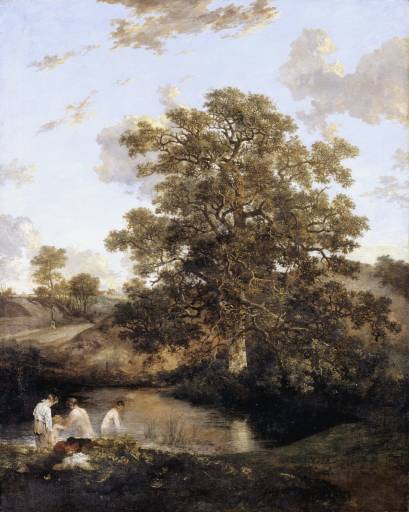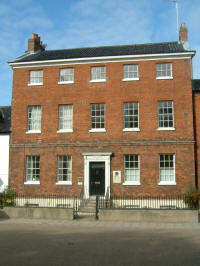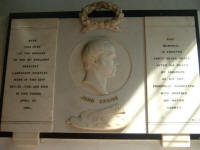Wealthy Norwich families - such as the Gurneys who
founded Barclays Bank - acted as patrons to the Norwich
artists. Crome was also employed to teach the Gurney
children art.Among the Norwich intellectuals was the writer and
translator William Taylor
- who gave lectures on art to the Norwich
Philosophical Society. In a lecture delivered in 1814 he
urged that architecture and townscapes should be
considered higher subjects than rural landscapes - a
comment which was almost certainly directed at John Crome. Crome was seen by many as the founding father of
the Norwich School and his works were predominantly
depictions of rural scenes. Perhaps his most famous
painting, now hanging in the National Gallery in London,
is The Poringland Oak - which shows three adults
and a child bathing
in a pond in rural Norfolk.

The Poringland Oak
Other famous rural depictions of his include Whitlingham
Church (now derelict) and Postwick Grove.
After returning to Norwich,
John Sell Cotman spent most of the rest of his life in
the county. However, he did gain a post as an art
teacher in 1834 at King's College in London and one of
his pupils was Dante Gabriel Rossetti. Cotman was
frustrated through out his life by, what he saw as, his
lack of success and by having to depend on teaching art
for a living. Cotman's water colours have a strength and
intensity which make them visually stunning. His
Norwich Market Place - which was exhibited in 1807 -
is a particularly effective piece - conveying the hustle
and bustle of the city on market day - with beautifully
drawn houses and St. Peter Mancroft's Church in the
background. Cotman also tackled a number of other famous
landmarks in Norwich including: Bishop Bridge and
Mousehold Heath.

Cotman House, No. 7 St.
Martin's-at-Palace-Plain in Norwich Other highlights from the Norwich School include
James Stark's and John Thirtle's paintings of Cromer,
Thirtle's boat builders near Cow Tower in Norwich and
Joseph Stannard's water frolics.
John Crome is buried in St. George's Church in
Colegate and there is a memorial to him on the back
wall. James Stark, John Thirtle and John Berney
Ladbrooke (son of Robert Ladbrooke) are all buried in the
Rosary Cemetery off
Rosary Road.

Memorial to John Crome |

